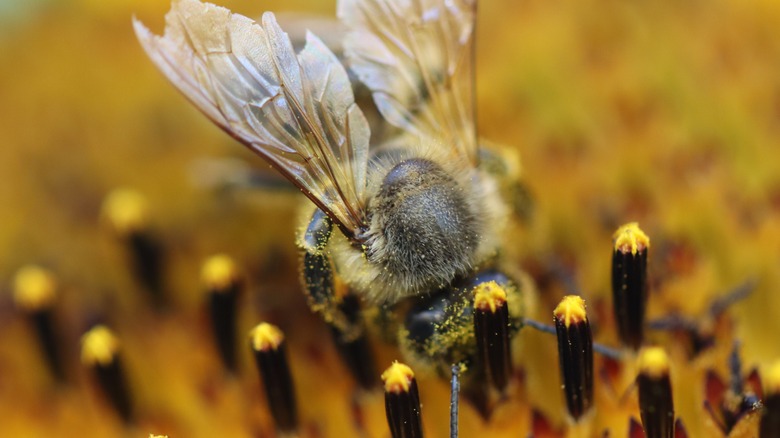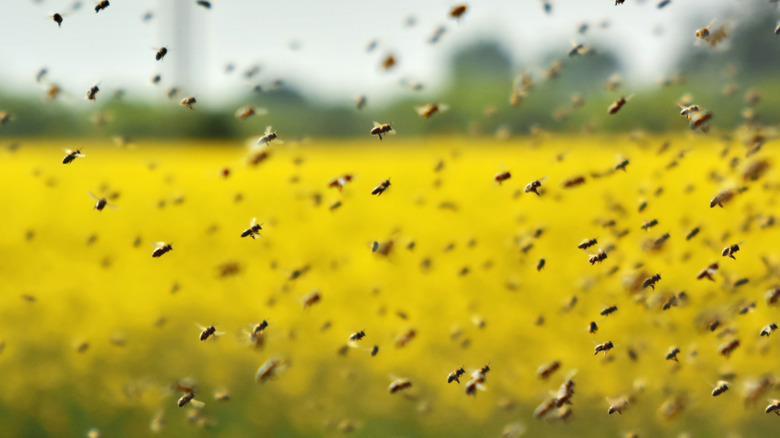The Scientific Reason Why Bees Can Generate A Stunning Amount Of Electricity
The life of the average bee can't be an easy one, and the world certainly wouldn't be better off if all the bees died. These fluffy little souls are often seen buzzing around on warm summer days, flitting from flower to flower, seemingly without end. As Phrase Finder reports, the term "busy as a bee" was reportedly first recorded in "The Canterbury Tales" by the iconic Geoffrey Chaucer. For centuries, then, we've known just how hard these insects work.
For honeybees, unsurprisingly, life revolves around painstakingly making honey. According to the RSPB, honeybees have separate honey stomachs, where the nectar from flowers is stored until it can be developed into honey by the clever creatures. They do this by passing it between each other through their mouths, until it has reached the right consistency. This is how it, famously, comes to be stored in the hive.
While some species of bee are an exception, they are social creatures, by and large. A swarm of bees can be an intelligent, organized, and incredibly intimidating prospect. It seems that a big group can generate an enormous amount of electricity. Here's how they do it.
A single bee may not be considered much of a threat. After all, they tend to be docile, and can even be considered rather cute. The smallest bee in the world, according to Guinness World Records, is the species Perdita minima. Less than two millimeters long, it's found in the United States (though not very easily, because it's tiny).
The electricity in the atmosphere
Per the Natural History Museum, Dr. Warwick E. Kerr introduced killer bees in the 1950s when he tried to cross breed African and European bees with the hope of creating a more resilient species to produce more honey. The result was quite a diminutive bee, but one that creates hives in all kinds of areas where they may be disturbed. When they are, the outlet reports, they will furiously swarm the perceived threat, sometimes in their thousands or even hundreds of thousands.
According to Pests, the best defense against such an onslaught is simply to hurry away. The cunning critters have been reported to wait above the surface if their target attempts to escape into water. A swarm of bees, particularly these aggressive ones, is nothing less than an absolute force of nature. Perhaps it's not so surprising, then, that a honeybee horde can create an awful lot of electricity.
The November 2022 study "Observed electric charge of insect swarms and their contribution to atmospheric electricity" from Ellard R. Hunting et al (via iScience) explains this phenomenon more closely. The study explains that the Earth's atmosphere has an inherent electricity: "It is conventionally observed as the vertical Potential Gradient (PG), essentially the voltage difference between the Earth's surface and a point (often 1 m) above it." This is influenced by all kinds of factors, some natural and some, unsurprisingly, influenced by humans. Surprisingly, though, insects also have a considerable effect on it.
The butterfly effect has nothing on the bee or locust effect
"A wide array of airborne insect species have been shown to carry an electric charge ... " the researchers report in "Observed electric charge of insect swarms and their contribution to atmospheric electricity" from Ellard R. Hunting et al (via iScience). Once again, it's a nigh-imperceptible amount on an individual basis, but great swarms of honeybees have a powerful effect.
The University of Bristol's School of Veterinary Sciences, per the study, is home to several bee hives, and observing them with an electric field monitor led the scientists to conclude, " ... [A] honeybee swarm contains enough charge to affect the atmospheric PG, proportional to the swarm density." Using this research, and what is known of the electrical charge of locusts, the study further concluded that these infamously huge and dense swarms "have the potential to alter their local electrical environment with a magnitude comparable with meteorological events."
Hunting told CNN that insects' wings, individually, carry an electric charge that is generated as their wings flap away furiously. So do lots of other things: "For instance, flowers have an electric field and bees can sense these fields ... other bees can use that information to see whether a flower has been visited," the expert said. Nonetheless, the amount of electricity these great groups generated was unexpected. Per CNN, the study stated that the effect could be comparable to that of a storm cloud or thunderstorm.


